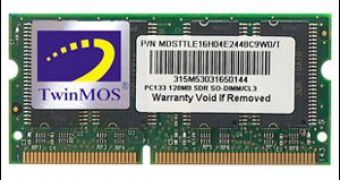TwinMOS has announced the release of a new line of DDR3 memory modules for notebook computers to operate at speeds up to 1333MHz. The memory modules are alleged to bring a performance boost in the mobile area and at the same time to be more energy-efficient than the current 667MHz DDR2 standard can provide.
"This new-generation DDR3 SO-DIMM module for laptops uses the 8-bit pre-fetch design. As it is a double of the DDR2 modules, the clock frequency begins from 800MHz and can be increased to 1066MHz and 1333MHz. Prior to this, its 204-pin design platform is different from the 200-pin design in DDR2 modules for laptops. Thanks to the evolution in die processes, the working voltage of DDR3 modules for laptops has been reduced from 1.8V of DDR2 modules for laptop to 1.5V", the company's press release says.
The notebook business is memory-starved since the advent of Windows Vista, which has dramatically changed the memory and storage performance requirements. The new memory modules from TwinMOS are the result of a close collaboration with major semiconductor manufacturers such as Micron Technology, Elpida Memory and Qimonda AG and they use genuine die from original manufacturers packaged with the FBGA (Fine-Pitch Ball Grid Array) technology to meet the best electrical performance.
Modules running at high speeds feature low signal feedback due to the ODT (on-die-termination) process that ensures the signal integrity, while the ASR (auto self-refresh) design cuts down the refresh frequency of memory modules in order to maintain low temperatures and power consumption at the same time.
Toshiba did not specify the availability date for their TwinMOS DDR3 1333MHz SO-DIMM memory modules, but the first notebooks to support DDR3 memory will be the ones built around Intel's next-gen platform, codenamed "Montevina". Scheduled for launch in mid-2008, Intel's platform will support 'Penryn', Intel's 45nm die-shrink of its current generation of 65nm Core 2 processors.

 14 DAY TRIAL //
14 DAY TRIAL //